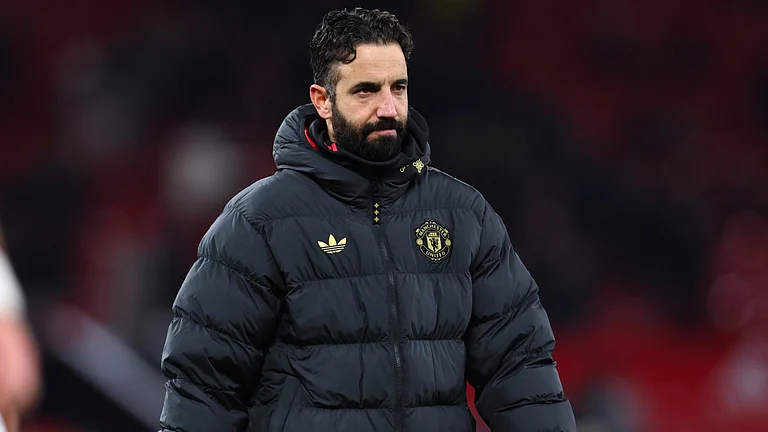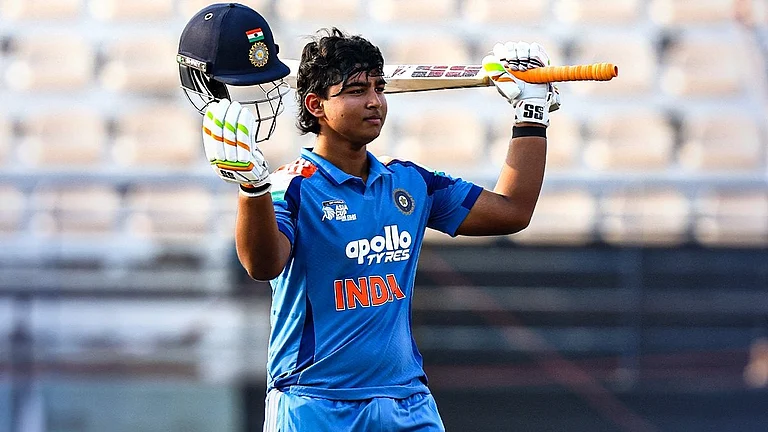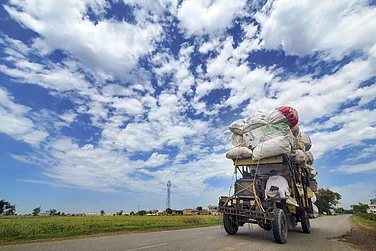Something of the controlled power and grace that flows in the proscenium spectacles he mounts is there in the man too. Leonine of manner and voice, but disarming in speech, Ratan Thiyam, the world-renowned theatre director from Manipur, who won the Outlook SpeakOut Award for Best Artist, reminisces about his life’s journey—an artist’s biography—in a conversation with Sunil Menon and Sreevalsan Thiyyadi:
If we may start by asking, where did Ratan Thiyam begin? Could you describe your initial years, the milieu…who was Ratan Thiyam before he came to NSD as a student?
Well, I’m a very common man, a small fry. I was born and brought up in an artistes’ family. My father, my mother were both well-known gurus of Manipuri classical dance. As it happens in artistes’ families, you don’t get much time for your children. That’s what happened in my case too. You could say I was born and brought up in costume boxes! My playground was on the wings of the stage...in the greenrooms. The most fortunate part of my life was that my parents engaged the best of Manipuri artistes in their troupe. It was a boon for me, although I didn’t realise it then…in my subconscious I had learnt quite a lot, because I was witnessing it daily for many, many years.
My parents were going out, travelling all the time…so my formal education was a little disturbed. I told them I would like to stay back in Imphal. Those surroundings gave me quite a lot. It was a phase where I started observing the common life of Manipur, the orphans, pickpockets, thieves, the constables. I was in Johnstone High School, a very prestigious school, situated in the heart of town. All the cinema houses were nearby. So naturally we used to go out of the class and watch films (laughs)…
What films were running those days?
The popular ones, like Samson and Delilah, Hercules, those cowboy films of John Wayne, and Hindi too...Dilip Kumar, Dev Anand, Raj Kapoor. From the very beginning, I was also very interested in painting. Afterwards I went to art school. All those experiences of life… I learnt Hindi from Hindi films!
Along with that early initiation into classical aesthetics….
Yes, you see. That was in my subconscious. It was like a treasure house. But I never knew that. I realised it only when I started thinking about art. Then gradually it started coming. Like page after page, page after page…like reels of films.
This would be the Sixties.
Yes...and along with what we got from the environment, we had really very good teachers those days. Honest, and giving us the gift of their simplicity and real experience of life.
What was the local theatre scene like those days?
I’ll tell you how I came to that. I’d joined art school. And also, I started writing. I published my first short story collection in 1965. In 1967, ’68, ’69…I was writing a lot, novels, poetry. So I was invited by the Cultural Forum of Manipur to be the associate editor of their journal, Ritu. It was a good, serious literary journal, very respected. I began to review theatre for it. I felt I was ill-equipped, a zero, so I started reading. I had to know the things I was touching on! The Forum would hold festivals of modern plays. Before that, Manipur had a great tradition of Parsi theatre. The style was Parsi, but with Manipuri actors….
And the modern stream?
You see, Manipur has a very different kind of history in theatre. Very less of realism in tradition, so those days it was leaning more towards, say, the theatre of the absurd. Instead of realistic theatre, like Ibsen or Chekhov, which was also staged, people leaned more towards Beckett, Pinter, Ionesco, Sartre...all that. And I was reviewing. It was my job! In that situation, I felt, you know, illiterate! I didn’t know much about European theatre. So I started studying it.
Which play was this?
Nabab Nandini…. And one day, as it happens in amateur theatre, the two heroes started fighting and at the last moment one of them was out! (Laughs) And the director said “Ratan, you do it”. That’s how I came on stage. But you see, very early, I’d said to myself: “Never in my life will I do performing arts”. Because I’d suffered so much in my life with all that touring my parents did. But here I was, my journey took me to the stage! After that, I was invited by many troupes to act, to write, direct. I’d always thought that if you want to do something, you have to do it professionally. That’s how I came to the National School of Drama. When I went back after NSD, I felt I should start a professional repertory. Without any money, I started the spadework in 1975. By ’76, the Chorus Repertory Theatre was fully established.
And you crafted a whole new idiom. So much so that Peter Brook said two things in India impacted him deeply: Kathakali, and Manipuri. He meant you essentially. What went into Ratan Thiyam’s theatre? NSD, to begin with…
At NSD, we had really great teachers. Mr Ebrahim Alkazi was a living legend, as a teacher, as a director, everything to do with theatre. Even as a person. Very good students too then, no dearth of talent. We learnt a lot. Indian theatre didn’t have a lot of modern written material those days. The most important thing I learnt, particularly from Mr Alkazi: professionalism. Mount everything professionally. Whatever you do, aim at perfection. That was the motto. That I learnt from him.
And apart from the exposure to all that western canon?
Well, when I went back to Manipur, I said to myself, “Well, Ratan Thiyam, now you know about Greek theatre, about European theatre, about many other types of theatre in the world, but you do not know yourself”. You don’t know about your own country, your own region. So I asked my father, my mother who had come back...the great gurus…I requested him, “Father, I want to learn.” He said, “You are coming from NSD? Why do you want to do this?” I told him that I felt myself to be so illiterate now about Manipuri’s own classical aesthetics, what gave it that great power. So he requested many of the greatest gurus of Manipur to teach me. And they all came. I sat at their feet for four years, continuously. That’s how I felt myself a little equipped, some weapons I could draw on.
And all of it came together…
It was a phase when I experimented, traditional performing arts, classical and other traditions, contemporary theatre. It was a very good exercise. Gurus, as you know, are on the other side. I would put it together and show it to them, my gurus, and sitting at their feet, ask them whether I’m doing justice to all these forms, the contemporary quality, the traditional. They would say, “You are doing okay, but you shouldn’t do this, you should have done this bit like that.” This is how the laboratory process started. My journey of theatre.
I don’t look at theatre only as a performance. For me, it is a site of all-the-time experimentation. And I’m in the laboratory somewhere. I also feel I don’t do theatre for the audience. Audiences are like gods and goddesses. My philosophy is that I want to satisfy myself. Art is for myself. Not for anybody in this world. If I’m satisfied…you know the story of Sabari’s berries. I taste it first, whether it’s sweet or sour. If it’s sweet, if it’s aesthetically growing, then only I share it with the audiences. If it’s sour, I discard. That’s how it becomes a house of experimentation. There are many plays which have never seen the light of day.
It was difficult for me, putting myself through this procedure before getting to performance. But that’s how I have been, before I took it to all those big international festivals. It’s a kind of futuristic orientation. Nobody can talk about the future of course, but you push yourself and it will lead somewhere. One has to go on experimenting. I don’t believe in doing a production in 15 -20 days or one month.
Typically how long do you take?
Sometimes I take two-three years. It also takes a lot of research work, a lot of travel. Take Uttar Priyadarshi, a Buddhist tale, written by Agyeya. Before doing it, I travelled to London, France, Tokyo, Thailand, Rangoon. It was a search for hell. In India, the concept of hell is something. But I wanted to know the western hell too...the dungeon. The modern hell. And talk to the monks in Thailand, go to the monasteries of Myanmar. All that takes a lot of time. I’m not a very good intellectual person, you see. It’s not easy for me, it takes time. Even the aesthetics of the production, putting it together is quite a painful process. Just doing a performance is nothing.
The thematic movement being brought about by the whole choreography, the sets, the music...
You’re right. While doing Macbeth, for instance...for me, there is no man called Macbeth. Macbeth is only an interpretation, an idea. Macbeth is not a person for me. Macbeth is, rather, a disease for me. A disease of unlimited desires, greed, violence. Doing that took a lot of time. To understand, to think. The structure, the choreography. How to penetrate the space itself. The penetration of the space by the witches. And of Lady Macbeth. And thinking...Macbeth is only one, not two. Lady Macbeth doesn’t carry a name. She is a part of Macbeth. I interpret it like that. People may or may not agree.
From Macbeth to Chakravyuh. Do you somehow see the figure of Abhimanyu as a kind of metaphor for Manipur? And of communication being necessarily an incomplete thing?
It’s a fact in this world. That’s why I wanted to bring a universal touch to it. The figure of the martyr, the shaheed, we do not really respect them much. Abhimanyu is a kind of shaheed. Although the play had come out of ’80s Manipur, where I could see a gap between the generations, between the young and old. It’s a trap you’re in despite your education. Look at Abhimanyu, he’s very learned, but he’s pushed into this trap. The journey, the notion of making recognition for yourself, the tendency, the urge that you want to make something in this world, as a young man, it’s in the personality of Abhimanyu. Though he belongs to the Pandavas, he is very individual. The elder generation wants to give, but cannot. There’s a clash. The world changes like that.
You have drawn a lot from the epics….What brought you to this relationship?
I had a teacher, Kalachand Shastri, who translated the entire Mahabharata into Manipuri. He inspired me a lot. He used to write amazing interpretations of the Gita. The epics are so beautiful…take Chakravyuh, it’s not only a play but a kind of fruit, both sour and sweet. A beautiful fruit. The Drona parva is so beautiful. In Chakravyuh, there are two flags, a part of the choreography where the Pandavas and the Kauravas are with flags and dancing. Would you believe it, I was actually INSpired by the flags at the UN building in New York! Lots of flags. When I looked at the flags, I said to myself, all these flags come under only two flags...one is America, one is Russia (laughs). In my subconscious, war is a reality. War has been there, all the time, surrounding us.
How much have you been interested in or drawn from other traditions in India? And outside?
I have travelled everywhere in India. Every state. I observed many, many things. It was my personal study tour. I speak Meitei language, and I’m from Manipur, and the most important thing for me was to understand other cultures. Culture is not arts and performances, it’s the etiquette, it’s the moral quality of people. Manipuri culture is very specific…its Tibeto-Burman phonetics and Southeast Asian elements. And you have Indo-Aryan, Dravidian. Everything put together makes such a big tableau. Beautiful flowers, fragrances, aesthetics. The more you know about them, the more tears roll down. You go to Kerala, Guruvayur, and early morning you go to the pond, come up with wet clothes, then do the whole parikrama, look at the deity, the great elephants with the chamaram...it inspired me. You know, I used elephants for Uttar Priyadarshi.
One sees your plays, and you see family resemblances. To Kathakali, Balinese theatre, Japanese….
You tend towards a very non-verbal style…
You see, there are two types of languages. One is for ordinary understanding. But the language of expression is with everything you have. It has more to do with the energy. The space in a performance is more important than language. How to penetrate that space. Your sounds, you see, your voice, your words…one word may be stronger than a sentence. You make a soundscape in that entire space. You can’t compare that with a hundred words. It is much stronger.
And music?
Yes, music too is that. It’s a part of the entire echo, the space craft. Your sound enters, your word enters, and if you want to make it more powerful, your whole body enters. Acting is not just the face, it’s the entire body. The entire body has to play with the space. The space is a garden and here is the actor playing with that!
You’ve seen it from both sides. As NSD director, and from the local space, with all its new elements, Manipuri cinema, its world influences.
Yes, Manipuris are interested in many things. My nephew is a well-known filmmaker, Haobam Paban. My son Thawai is into theatre. His training was from Japan. My eldest daughter is also a filmmaker. And my youngest daughter is a musician, she learnt from Allahabad University. We eat whatever comes from that. The economic condition of art in this country is not good. Whether it’s painting or theatre, dance or music. In the last 70 years, the art economy has seen no growth. Look abroad, I tell you. Take Ariane Mnouchkine, take Eugenio Barba, take my very close friend Tadashi Suzuki...all these great theatre directors, they are very well looked after by the State. It’s a pity, I don’t want to speak out. It’s time to give respect to the artist. Look at Habib Tanvir. Look at Kavalam Narayana Panicker. He was very close to me, I called him chetta (elder brother in Malayalam). He loved me like that. Look at him. Such an authentic figure, such a powerful director of this century. And you won’t get another Kavalam. That realisation is not there.
























